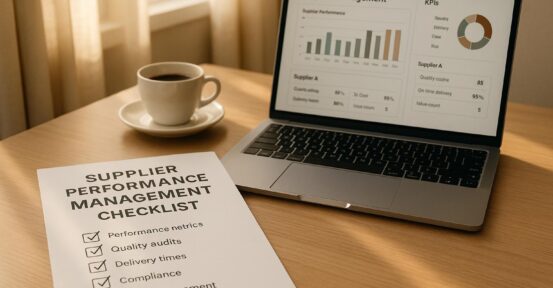
Supply chain bottlenecks can disrupt production, increase costs, and damage customer trust. These delays often stem from late deliveries, worker shortages, poor visibility, or trade disruptions. U.S. manufacturers, especially in regulated industries like aerospace and medical devices, face added pressure to resolve these issues quickly. Here are five effective solutions:
- Cloud-Based Platforms: Centralize supplier management for better communication, faster approvals, and real-time updates.
- Automation: Streamline quoting and supplier communication to save time and reduce errors.
- Supplier Performance Management: Use data scorecards to track quality and delivery metrics, ensuring accountability.
- Full Supply Chain Visibility: Leverage AI and IoT for real-time tracking and risk management across multi-tier networks.
- Risk Mitigation Strategies: Diversify suppliers, consider near-shoring, and monitor compliance to prevent disruptions.
These strategies, when combined, help manufacturers improve efficiency, reduce costs, and maintain reliability in competitive markets.
Webinar: The 3 Most Common Supply Chain Bottlenecks
What Causes Supply Chain Bottlenecks
Understanding the root causes of supply chain bottlenecks allows U.S. manufacturers to avoid expensive disruptions caused by external pressures or internal inefficiencies. These challenges typically fall into three main categories:
Trade and Economic Disruptions
Sudden shifts in trade policies, like tariffs or restrictions, can throw supply chains into disarray. Manufacturers might need to scramble for new suppliers or adjust their budgets to keep production running. Global events, such as the semiconductor shortage, highlight how international trade vulnerabilities can ripple through production lines. On top of that, currency value changes can increase the cost of imported materials, while delays along critical shipping routes can slow down the delivery of essential parts.
Worker Shortages and Skills Gaps
The lack of skilled workers is a major roadblock for many manufacturers. Finding experienced technicians in areas like welding, machining, or quality control has become increasingly difficult, pushing companies to invest more in training and hiring. An aging workforce and high turnover rates only add to the challenge, particularly during times of peak demand when consistent production is crucial.
Poor Supply Chain Visibility
When manufacturers don’t have a clear view of their supplier networks, they’re more likely to be blindsided by problems. Without real-time updates on supplier and sub-supplier operations, issues often go unnoticed until they’ve already caused delays. Outdated communication methods and inconsistent data management make it even harder to spot and fix problems quickly. Addressing these visibility gaps is key to preventing bottlenecks from spiraling out of control.
Solution 1: Use Cloud-Based Sourcing Platforms
Cloud-based sourcing platforms simplify supplier management and procurement by centralizing workflows and reducing inefficiencies. Instead of juggling scattered spreadsheets and endless email chains, these tools offer a streamlined, organized approach that keeps everyone aligned.
Main Features of Cloud Platforms
Platforms like QSTRAT are designed to tackle common visibility and communication challenges. Here’s how they help:
- Real-time supplier collaboration: Instantly connect with suppliers, ensuring faster responses and smoother communication.
- Centralized workflows: Manage everything in one place – purchase orders, quotes, supplier evaluations, and performance tracking are all housed within the system.
- ERP and CRM integrations: Seamlessly link your sourcing platform with existing business systems to automate data updates, reduce manual input, and minimize errors. For example, customer needs from your CRM can directly inform supplier requests.
- Automated workflows: Quotes are routed to the right decision-makers automatically, cutting out delays caused by manual processes.
These features directly address the challenges manufacturers face, delivering measurable improvements.
How U.S. Manufacturers Benefit
By eliminating bottlenecks, cloud-based sourcing platforms offer clear advantages over traditional methods. Here’s a comparison:
| Aspect | Cloud-Based Sourcing | Traditional Methods |
|---|---|---|
| Communication Speed | Instant messaging and notifications | Delayed email chains and phone calls |
| Data Management | Centralized and easily accessible | Scattered across spreadsheets and documents |
| Approval Process | Automated with clear timelines | Manual, often causing delays |
| Supplier Visibility | Full network overview | Limited insights into supplier status |
| Cost Tracking | Built-in analysis tools | Prone to errors with manual calculations |
| Compliance Monitoring | Automated alerts and checks | Manual tracking of certifications and standards |
The benefits are hard to ignore. Cost savings come from reducing administrative tasks and human errors. Improved supplier visibility means manufacturers can compare pricing more effectively, leading to better deals.
A unified platform improves communication by offering real-time updates for both suppliers and internal teams. Suppliers know exactly where and how to submit quotes, and they can track their status in real time. Meanwhile, internal teams have access to the same information, cutting down on confusion and duplicate efforts.
Regulatory compliance is another key area where these platforms shine. They automatically track certifications, quality standards, and regulatory requirements, helping manufacturers avoid compliance gaps. For industries like aerospace, which must adhere to ITAR regulations, or medical device manufacturing under FDA guidelines, this level of organization is critical to maintaining uninterrupted operations.
Finally, cloud platforms enable data-driven decision-making. Instead of relying on incomplete or outdated information, manufacturers can access a full view of supplier performance, cost trends, and quality metrics. This comprehensive insight leads to smarter sourcing choices that prevent future delays and inefficiencies.
Solution 2: Automate Quoting and Supplier Communication
Building on centralized sourcing, automating the quoting process takes procurement efficiency to the next level. Manual methods often slow down supply chain operations – teams relying on spreadsheets, lengthy email chains, or phone calls can find even straightforward requests dragging on for far too long. Automation simplifies this process, speeding up decisions and strengthening supplier relationships.
Speed Up the Quoting Process
Automated quoting systems eliminate the delays caused by traditional methods. Instead of juggling emails and spreadsheets, manufacturers can send quote requests directly through a centralized platform.
With tools like QSTRAT, requests are automatically routed to pre-qualified suppliers based on specific requirements, which improves both response rates and the accuracy of the data received. The approval process becomes smoother, as quotes can be sent to decision-makers simultaneously, and higher-value requests can be escalated automatically when needed.
Another advantage is the standardization of responses. Automation ensures that quotes arrive in a consistent format, making it easier for procurement teams to compare pricing, delivery timelines, and terms. This eliminates the need to reformat information from various sources and allows teams to quickly zero in on the best options. The result? Faster quoting and better insights that enable real-time supplier decisions.
Better Supplier Communication
Streamlined communication tools improve transparency and accountability throughout the quoting process. For instance, QSTRAT’s integrated two-way communication system gives suppliers real-time updates on the status of their quotes. This means suppliers can track submissions instantly, reducing the need for follow-up inquiries.
Automatic notifications keep everyone informed about updates, such as specification changes or adjusted deadlines. Additionally, a centralized message center consolidates all conversations tied to a specific quote, ensuring every detail is stored in one place. This not only simplifies communication but also creates a reliable record for future reference, making the entire process more efficient and traceable.
sbb-itb-827f251
Solution 3: Improve Supplier Performance Management
Just like cloud-based sourcing and automated communication, keeping a close eye on supplier performance is key to avoiding supply chain hiccups. When suppliers fall short, it can lead to delays, quality problems, and higher costs. Shifting from vague, subjective evaluations to clear, measurable assessments can make all the difference.
Track Performance with Data Scorecards
Performance scorecards turn supplier interactions into measurable data points. With real-time dashboards, you can see exactly how each supplier stacks up against your standards. Focus on two key areas: quality and delivery performance.
- Quality metrics include defect rates, order accuracy, and defective parts per million (DPM). Tracking these helps you spot trends early and address potential issues before they escalate.
- Delivery metrics measure on-time delivery rates and delivery accuracy, ensuring suppliers stick to schedules and send the correct products.
Tools like QSTRAT automate the collection of these metrics, generating scorecards that update in real time. These scorecards also track whether products meet your specifications and can include customer feedback on supplier quality. This data becomes invaluable during supplier reviews or contract renewals, offering actionable insights to tackle performance issues head-on.
Fix Compliance and Quality Problems
Armed with real-time performance data, you can quickly address compliance and quality concerns. Scorecards highlight specific problem areas, enabling you to take corrective action based on clear, measurable data rather than vague impressions. For example, monitoring defect rates and product conformity ensures you catch issues early and work with suppliers to fix them.
This data-driven approach not only helps suppliers meet quality standards but also minimizes disruptions during critical production periods. By setting clear, metrics-based performance goals, you can build stronger supplier relationships and drive continuous improvement throughout your supply chain.
Solution 4: Get Full Supply Chain Visibility
Operating without a clear view of your supply chain is like flying blind. Many U.S. manufacturers face challenges with multi-tier supply chains, where they know their direct suppliers but have little to no insight into second- and third-tier suppliers. This lack of transparency can lead to unexpected disruptions that ripple through production and cause costly delays.
True visibility means more than just knowing who supplies your parts. It’s about understanding the broader network – relationships, dependencies, and risk points – that can influence your operations. With a complete picture, you can spot potential bottlenecks and address them before they escalate into major issues.
Use AI and IoT for Supply Chain Tracking
Modern technology transforms guesswork into actionable insights. Artificial intelligence (AI) can analyze supply chain data to predict disruptions, while Internet of Things (IoT) sensors provide real-time updates on shipments and inventory. For instance, AI might identify weather patterns or logistical delays that could disrupt deliveries. This gives you time to adjust sourcing strategies, find alternative suppliers, or tweak production schedules before problems snowball.
IoT sensors take monitoring to the next level by tracking details like location, temperature, humidity, and even shock levels during transportation. This is especially critical for industries like aerospace or medical devices, where environmental conditions during shipping can directly impact product quality and compliance standards.
When combined, AI and IoT create a "digital twin" – a virtual model of your supply chain that mirrors real-world conditions. This allows you to test scenarios, evaluate risks, and make informed decisions without disrupting actual operations. Whether it’s adjusting supplier relationships or refining demand forecasts, this digital approach makes your supply chain smarter and more resilient.
Risk Management for U.S. Supply Chains
Managing supply chain risks effectively requires a multi-layered strategy that addresses vulnerabilities from different angles. For U.S. manufacturers, a few key approaches stand out.
- Supplier diversification: Relying on a single source for critical components is risky. By spreading procurement across multiple suppliers in different regions, you reduce the chance of a single disruption shutting down production. This approach has helped many companies weather global challenges.
- Near-shoring and reshoring: Bringing production closer to U.S. markets can cut transportation risks and lead times. While it may increase direct costs, it offers benefits like improved control over the supply chain and faster response times to changes or disruptions.
- Adopting technology platforms: Tools like QSTRAT help manufacturers manage supplier relationships and monitor performance in real time. These platforms provide the foundation for implementing broader risk management strategies.
The most effective approach often blends multiple strategies tailored to your industry’s needs. For example, aerospace companies might focus on advanced technology platforms and strict inventory controls, while automotive manufacturers may prioritize near-shoring and supplier diversification.
Achieving full supply chain visibility isn’t a one-and-done task. It requires ongoing monitoring, analysis, and adjustments. But the payoff is clear: when disruptions strike, visibility tools and proactive risk management keep production lines moving. Plus, these insights pave the way for continuous improvement, ensuring your supply chain remains resilient and adaptable in an ever-changing landscape.
How to Fix Supply Chain Bottlenecks
Addressing supply chain bottlenecks means combining the strategies discussed earlier. Each solution tackles specific challenges, but when used together, they form a cohesive system that improves overall efficiency.
Cloud-based sourcing simplifies supplier relationships and streamlines procurement processes. Paired with automation, these platforms reduce lead times and eliminate manual delays. Supplier performance management ensures accountability, while full supply chain visibility helps anticipate and avoid disruptions.
The real advantage comes when these solutions are integrated rather than used individually. For example, a manufacturer leveraging cloud-based sourcing can also use automation to speed up operations, monitor performance metrics, and gain visibility into their entire network – all within the same platform. This interconnected system delivers combined benefits that surpass what any single tool can achieve on its own.
For U.S. manufacturers, who are grappling with global competition and unpredictable supply chain challenges, adopting these technologies isn’t just about solving current issues – it’s about preparing for the future. Companies that embrace cloud-based, automated, and data-driven systems are better equipped to adapt to shifting trade policies, labor shortages, or unexpected crises. These technologies lay the groundwork for operational improvements that can make a lasting impact.
Key Takeaways for U.S. Manufacturers
U.S. manufacturers face critical challenges that these integrated solutions directly address. Here’s how:
- Cloud-based platforms like QSTRAT break down geographical barriers, giving manufacturers access to global supplier networks while maintaining centralized control. This broader reach leads to cost savings through competitive bidding and reduces reliance on single-source suppliers.
- Automation eliminates human delays in traditional procurement processes. Tasks that used to take days can now be completed in hours, which is crucial when competing for scarce components or responding to urgent production needs.
- Data-driven supplier management shifts relationships from reactive to proactive. By tracking real-time metrics like performance, compliance, and quality, manufacturers can make smarter sourcing decisions and strengthen supplier partnerships.
- Enhanced visibility enables better decision-making. With clear insights into supply networks, manufacturers can optimize inventory levels, cut carrying costs, and improve cash flow. It also allows for more transparent communication with customers about delivery schedules and potential delays.
When combined, these solutions improve efficiency, reduce costs, and foster stronger supplier relationships. U.S. manufacturers can offer competitive pricing, faster delivery, and higher-quality products while staying agile in a constantly changing market. This integrated approach ensures they’re ready to tackle both current and future challenges.
FAQs
How can cloud-based platforms help manufacturers manage suppliers more effectively?
Cloud-based platforms make managing suppliers easier by providing real-time access to data, improving communication, and automating essential tasks. These tools give manufacturers better insight into their supply chain, helping them monitor performance, spot bottlenecks, and resolve issues faster.
Here are some key advantages:
- Improved collaboration: Clearer and quicker communication with suppliers leads to faster decisions and stronger working relationships.
- Automation of tasks: Routine processes like quoting and tracking supplier performance are automated, saving time and reducing mistakes.
- Lower costs: Streamlining operations and cutting delays help manufacturers reduce expenses while building a more reliable supply chain.
By leveraging these tools, manufacturers can respond more effectively to challenges and keep operations running smoothly across various industries.
What are the benefits of automating quoting and supplier communication in supply chain management?
Automating quoting and supplier communication in supply chain management brings a host of benefits. For starters, it accelerates the delivery of quotes, ensures pricing is more accurate, and keeps compliance on track. This means teams can dedicate more time to closing deals and increasing overall productivity.
On top of that, automation helps operations run smoother, supports scalability, and unlocks valuable insights based on data. By simplifying these workflows, businesses can create a better experience for both customers and suppliers, ultimately boosting performance across the supply chain.
How do AI and IoT technologies improve supply chain visibility and help manufacturers manage risks?
AI and IoT technologies are transforming how manufacturers manage supply chains by boosting visibility and tackling risks head-on. With IoT sensors, manufacturers can gather real-time data on critical aspects like equipment health, inventory status, and transportation conditions. This means they can keep a closer eye on operations and quickly address potential problems as they occur.
AI takes this a step further by processing the data to uncover patterns, anticipate disruptions, and suggest preventive actions. By working together, these tools empower manufacturers to make quicker, data-informed decisions, minimize downtime, and keep their supply chains running smoothly.



